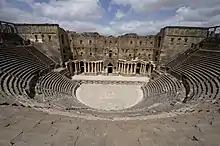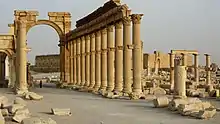Directorate-General of Antiquities and Museums
The Directorate-General for Antiquities and Museums (DGAM); Arabic: المديرية العامة للآثار والمتاحف, French: La Direction Générale des Antiquités et des Musées) is a Syrian government owned agency that is responsible for the protection, promotion and excavation activities in all sites of national heritage in the country. The directorate was established shortly after Syria's independence in 1946 under the central supervision of the Ministry of Culture.[1]
 Coat of arms of Syria | |
| Agency overview | |
|---|---|
| Formed | 1946 |
| Jurisdiction | Syrian Arab Republic |
| Headquarters | Damascus |
| Agency executive |
|
| Parent department | Ministry of Culture |
| Parent agency | Government of Syria |
| Website | www |
General overview
Its tasks emerged during the first years of independence in discovering, preserving, and protecting the data of the Syrian heritage, conducting studies on archaeological finds, and drafting the laws governing this, which were mentioned in the antiquities law and its amendments.
With the development of archaeological work and the increase in discoveries, its tasks expanded and its scientific and administrative responsibilities multiplied to include all cities and regions in the Syrian Arab Republic.
The progress of archaeological work in the country and highlighting the features of the Syrian civilization.
Nationally: through the rehabilitation of archaeological sites, museum management, seminars, conferences, publications, and publications of a historical and archaeological nature.
Internationally: Through archaeological exhibitions and various international participations through archaeological conferences and forums, and according to the scientific activity of the Directorate General of Antiquities and Museums[1] for more than half a century, it was able to introduce the world to the chapters of the ancient Syrian civilization and added to the history curricula in the world's universities and research centers ancient Syrian sciences, so it became These universities teach the flourishing prehistoric civilizations in Syria.
Thus, Syria became the focus of the attention of historians, archaeologists, and linguists, due to the data presented by the Syrian land that discredited many people's beliefs about the history of human civilizations in all historical eras known to mankind, because the Syrian land has embraced very important evidence for each era.
In 2012, Prof. Dr. Maamoun Abdulkarim was appointed as director-general until 26 Sep. 2017.[2]
Organization
The Directorate-General is split into several different direct directorates including:[1]
- Directorate of Museum Affairs: Responsible for the management and development of all Syrian museums, in addition to supervising any foreign exhibition of Syrian artefacts.
- Directorate of Excavations and Archaeological Studies: Responsible for the managing, organizing and supervising excavation works inside Syria and cataloging any findings.
- Al-Bassel Center for Archaeological Research and Training: Responsible for the over-all process of research and training, in terms of publications and special-purpose courses.
- Directorate of Planning and Statistics
- Directorate of Historic Buildings
- Directorate of World Heritage Sites
- Directorate of Information Communication & Technology: Responsible for providing the proper tools, infrastructure, and training to develop, manage, and publish databases of museum objects, historical sites and monuments, and spatial information to help decision-makers.
As of 2011, its library contains some 14,000 volumes.[3]
World Heritage List Sites in Syria
- Ancient City of Damascus[4]
 Old Damascus
Old Damascus - Ancient City of Bosra[5]
 Bosra Roman Theater
Bosra Roman Theater - Site of Palmyra[6]
 Palmyra, Monumental Arch and Columns
Palmyra, Monumental Arch and Columns - Ancient City of Aleppo[7]
 Aleppo Citadel Entrance
Aleppo Citadel Entrance  Crac des ChevaliersCrac des Chevaliers and Qal’at Salah El-Din[8]
Crac des ChevaliersCrac des Chevaliers and Qal’at Salah El-Din[8] Qa'alat Salah al-Din
Qa'alat Salah al-Din- Ancient Villages of Northern Syria[9]
 Kharab Shams Basilica, Dead Cities
Kharab Shams Basilica, Dead Cities
See also
- Directorate General of Antiquities – the comparable government department in Lebanon
References
- "home en". antiquities & musums. Retrieved 2023-02-13.
- ًWMF Journal. The Impact of War on Syria's Archaeological Sites and Damage Prevention Efforts. Archived from the original on 2014-12-10. Retrieved 2014-12-07.
- World Guide to Libraries (25th ed.), De Gruyter Saur, 2011
- Centre, UNESCO World Heritage. "Ancient City of Damascus". UNESCO World Heritage Centre. Retrieved 2023-02-13.
- Centre, UNESCO World Heritage. "Ancient City of Bosra". UNESCO World Heritage Centre. Retrieved 2023-02-13.
- Centre, UNESCO World Heritage. "Site of Palmyra". UNESCO World Heritage Centre. Retrieved 2023-02-13.
- Centre, UNESCO World Heritage. "Ancient City of Aleppo". UNESCO World Heritage Centre. Retrieved 2023-02-13.
- Centre, UNESCO World Heritage. "Crac des Chevaliers and Qal'at Salah El-Din". UNESCO World Heritage Centre. Retrieved 2023-02-13.
- Centre, UNESCO World Heritage. "Ancient Villages of Northern Syria". UNESCO World Heritage Centre. Retrieved 2023-02-13.
External links
- Official website
 (in Arabic)
(in Arabic)